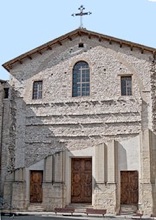


The church stands on the site of San Martino, which was first documented the 11th century and which gave its name of this area of the city.
The Dominicans began the present church in the late 13th century and extended it for the first time in 1339. It took on its present form in the 15th century, when the last bay of the nave was demolished. The arch below the roof in the present incomplete facade provides evidence of this demolition. During this remodelling, the presbytery was extended over the city walls and a transept was added.
The Tribunale dell’ Inquisizione was established at San Domenico in 1631, just after the incorporation of Gubbio into the Papal States. (Successive Dukes of Urbino has previously vetoed the establishment of such an office).
[Suppression ??] The church now serves the surrounding parish.
Interior
The interior largely dates to 1765, when the ceiling was vaulted and a number of niches were inserted around the altars in the nave.
Frescoes (ca. 1400)
These frescoes came to light during the restoration of the interior 1992. Those that can still be identified include:
-
✴in the 1st chapel on the right:
-
•the Madonna and Child with St Ubaldus; and
-
•the Coronation of the Virgin;
-
✴in the 2nd chapel on the right:
-
•the Annunciation with SS Sebastian and Roch; and
-
•the Epiphany; and
-
✴in the 1st chapel on the left:
-
•St Catherine of Alexandria enthroned;
-
•the Flagellation;
-
•Christ’s prayers in the garden of Gethsemane; and
-
•Christ and the Virgin.
Scenes from the Life of St Peter Martyr (15th century)
These frescoes in the 2nd chapel on the left were recovered in a restoration of 1922. They are traditionally attributed to Ottaviano Nelli.
Lectern (16th century)
The lectern in the choir has traditionally attributed to Mariotto di Paolo Sensi, il Terzuolo, although recent scholarship has thrown this attribution into doubt.
Circumcision of the baby Jesus (1603)
This altarpiece in the left transept is signed by Felice Damiani and dated by inscription. [Three kingdoms ??]
St Antony Abbot (16th century)
This terracotta statue on the 7th altar on the left is traditionally attributed to Giorgio di Pietro Andreoli (Mastro Giorgio).
Pietà (early 15th century)
This terracotta sculpture is on the altar of the 6th chapel on the left.
Frescoes (ca. 161o)
These frescoes in the 6th chapel on the left, which are attributed to Virgilio Nucci, depict:
-
✴St Mary Magdalene and the Risen Christ (Noli me tangere);
-
✴the stigmatisation of St Francis; and
-
✴the penitent St Jerome.
SS John the Baptist and Ubaldus (ca. 161o)
These frescoes in the 6th chapel on the left are attributed to Federico Brunori.
St Mary Magdalene (1612)
This altarpiece, which is by/attributed to Giovanni Baglioni, is in the 6th chapel on the left. [Dated by inscription ?]
St Vincent Ferrer (ca. 1455)
This altarpiece, which is attributed to Giacomo di Benedetto Bedi, is in the 5th chapel on the left. It was probably painted shortly after the canonisation of St Vincent Ferrer in 1455.
Madonna with Child and Angels (1546)
This fresco forms the altarpiece in the 4th chapel on the left. It is attributed to Raffaellino del Colle and [dated by inscription ??]
Miracle at San Domenico in Soriano (ca. 1655)
This altarpiece, which is attributed to Francesco Allegrini, is on the 5th altar on the right. It depicts a miracle that occurred in 1530 at the sanctuary of San Domenico at Soriano in Calabria, when the Virgin and SS Mary Magdalene and Catherine of Alexandria appeared to one of the brothers and gave him an image of St Dominic. This representation also includes the Dominican SS Hyacinth, Louis Bertrand and Pius (Pope Pius V).
Adoration of the Shepherds (ca. 1575)
This panel in the 6th chapel on the right is attributed to Girolamo Danti.
Communion of the Apostles (16th century)
This panel in the 7th chapel on the right is attributed to Giuliano Presutti. It was restored in 2010.
St Albert of Montone (ca. 1794)
This altarpiece was commissioned from Giuseppe Reposati for the church of Santa Maria dei Battilana (see Walk I) in preparation for the celebration of the 500th anniversary of the death in 1294 of St Albert: he had been Priors of the Eremo di Fonte Avellina, and his cult had been confirmed in 1782. [It was presumably moved here when Santa Maria dei Battilana was deconsecrated - when was that? Where in San Domenico is it now?]
[Check if the following altarpieces by/attributed to Francesco Allegrini are still in San Domenico:
-
✴St Catherine of Siena (ca. 1652-4)
-
✴St Rose of Lima (ca. 1672)]
Art from the Church
St Vincent Ferrer (16th century)
This altarpiece in the Museo Diocesano is by/attributed to Felice Damiani.
St Peter Martyr (17th century)
This altarpiece in the Museo Diocesano is attributed to Rutilio Manetti.

